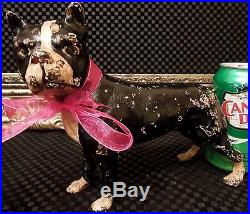
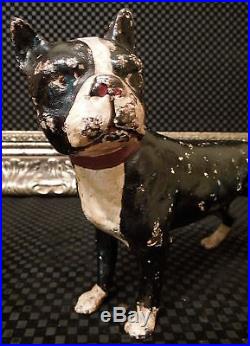
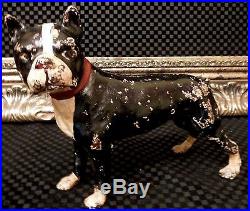
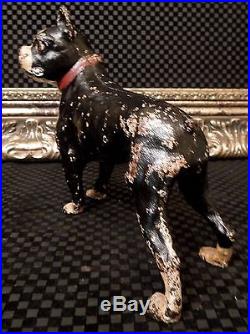
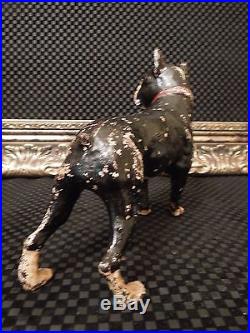
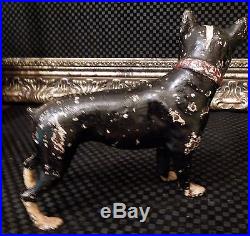
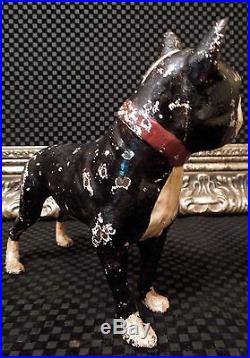
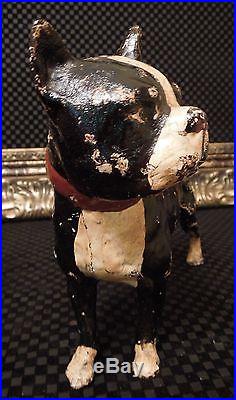
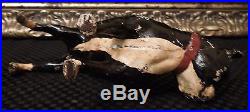
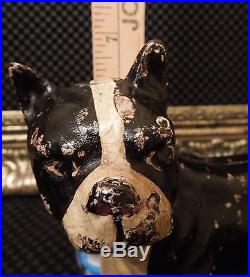
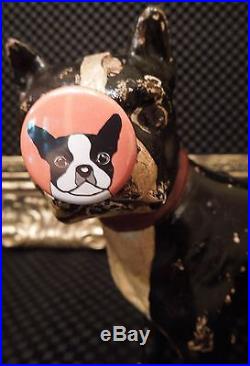
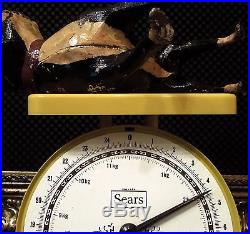

Item Specific: Today I offer you an original antique Boston Terrier by the famous sculpture artist SKOOG, signed on the collar (collar has been repainted and signature can be felt but hardly seen), and sculpted and cast in the likeness of a beloved war hero named’Stubby’. “Sergeant Stubby & The Dough Boys” (Original Oil by Terry Waldron). World War I Sergeant Stubby. Although the United States military did not have a War Dog program in place during WWI, there were plenty of military mascot dogs in the trenches with the American troops. The most famous was a dog named Stubby who became the first American War Dog Hero and this is his story. Stubby joined the 102nd Infantry, 26th (Yankee) Division, at Yale Field, New Haven, Connecticut in the spring of 1917. He was a bull terrier with a short tail from which he received his name. He was several weeks old at the time of his arrival. Robert Conroy was his only master. In July 1917, Stubby was smuggled aboard the S. Minnesota at Newport News, Virginia, and sailed to France. Stubby was at the war’s front lines in the trenches on February 5, 1918, and participated in seventeen World War I engagements. Stubby’s first battle injury was from gas exposure. He was nursed to health in a field hospital, but his near death experience made him very sensitive to the smell of gas. A few weeks later the Germans launched an early morning gas attack. The men in Stubby’s trench were sleeping. Stubby sniffed the air and then quickly ran through the trench barking and biting at the sleeping soldiers. Stubby’s alert saved many soldiers from injury. Stubby was an expert in locating wounded men in the “no man’s land” between the trenches of the opposing armies. Stubby would listen for injured men shouting in English. He would then run to them and bark for the paramedics. One day, while on patrol in no man’s land, Stubby heard a noise coming from a small patch of brush. He went to investigate and found a German spy making a map of the allied trenches. The German soldier called Stubby to him but it didn’t work. The German began to run and Stubby took off after him, biting at his legs causing him to trip and fall. Stubby attacked the German’s arms and finally bit and held onto his rear-end. When the allied soldiers arrived on the scene they realized Stubby had captured a spy. In a later battle, Stubby was wounded with shrapnel in his chest and right leg from a German grenade. He was rushed to a field hospital and stabilized after several operations. When Stubby was well enough he spent his time visiting the wounded soldiers and socializing with the nurses. After healing, Stubby rejoined the Yankee Division. After the Armistice, Stubby met President Woodrow Wilson during his visit with the 102nd Infantry in France on Christmas Day 1918. Stubby became an American folk hero and participated in many parades, war bond rallies, and hospital visits. Stubby was rewarded for his service with many military service medals, badges, patches and a promotion to sergeant. In 1921, General John J. Pershing awarded a gold medal to Sgt. That same year, Sgt. Stubby visited the White House to meet President Harding and again in 1924 to meet President Coolidge. Stubby died on March 16, 1926. His remains are preserved at the Smithsonian Institution. I feel it is in very good+ investment condition; be sure to look close at all 11 pictures since photos are an item’s best description. Importantly, this piece of American history in the proud memory of Stubby, a hero Boston Bull Terrier Dog and is made by the Dutka Liebl Foundry of Boston, designed by famous Swedish artist sculptor Karl Frederick Skoog. Sgt Stubby’s mold represents him earnestly… Since he had an injury in battle, and as it was in life, this right leg injury is represented in his famous and impressive memorial casting. This color variation is the exact style that can be seen in the Smith’s Doorstop Collector’s guide (another variation of paint has been acknowledged to be a matt deep espresso brown-black color with gold dotted collar and signature). A Skoog sculpture is not airbrushed but rather hand painted. He is a highlight of artistry and was valued at 650.00 nearly 15 years ago! This is from the cast iron heyday era lasting from 1880’s into the early 1940’s. There is no structure damage that I see but please use the zoom tool to be double sure I have not overlooked anything important or unimportant in my observations. Completely stable, meaning, no parts are missing or have ever been glued back on and there is no evidence of repair. Finish is appropriate as well as texture for a makers typical materials; Paint or patina is guaranteed to be original although as noted above the collar was definitely repainted and the feet tops may have been touched up long ago. Please use the photo’s as the most important part of the description for size, maker and marks, as well as all aspects of condition. Item or like item is in the Collector’s Guides. Weight is shown in photos. A soda can is 5 tall. All my listings are basically the same from here down: How can something so’durable’ be so’rare’? Many victorian and turn of the century cast iron and metal figural items are rare or completely lost because of wartime efforts that took place for nearly half of the last century. During the Great War, World War II and beyond, there were constant neighborhood drives to collect all non-essential cast iron and metal goods. These items were then melted down for their materials to help with the manufacturing for our wars necessities and armament. In regards to toys, well, toys were just that, toys. They got used hard and thrown away. So that’s why if you find one, you should consider it a prize, and if you are a serious collector, you probably consider it priceless. To Collector’s these figural are basically time capsules of a bygone era, wearing their beautiful battered and worn paint proudly, and have intense historical value as authentic artistic creations of this counties industrial age pioneer heroes. That said, items that or broken, missing parts, or repainted, even beautifully, can ruin an items investment value. Also, having no investment value at all are the current pieces being recreated overseas. The Business: Since I find these little treasures everywhere from thrift stores to estate sales and everyplace in between, I can not verify the origin of many pieces. All of my items will come to you in fresh, clean and safe packaging. More than likely, I will not have cleaned the items; Antiques Roadshow cautions not to clean so many different things therefore I will leave that up to you. My mission is to sell the things I have more than one of and other knick-knacks I discovered along my way, even tearfully part with the rarest of rare pieces to fund life’s ongoing adventures. I always leave feedback once I have received yours, this way I know your product made it into your waiting happy hands. I also have a brick and mortar location of The Dutchess of Arkansas inside The Rose Antique Mall should you ever visit the NWArkansas… The item “Stoic Antique SKOOG Boston Bull Terrier Dog WWI HERO’STUBBY’ Cast Iron Doorstop” is in sale since Thursday, May 29, 2014. This item is in the category “Antiques\Decorative Arts\Metalware”. The seller is “susiessensations” and is located in Bella Vista, Arkansas. This item can be shipped to United States, Canada, United Kingdom, Denmark, Romania, Slovakia, Bulgaria, Czech republic, Finland, Hungary, Latvia, Lithuania, Malta, Estonia, Australia, Greece, Portugal, Cyprus, Slovenia, Japan, Sweden, South Korea, Indonesia, Taiwan, South africa, Belgium, France, Hong Kong, Ireland, Netherlands, Poland, Spain, Italy, Germany, Austria, Russian federation, Israel, Mexico, New Zealand, Singapore, Switzerland, Norway, Saudi arabia, Ukraine, United arab emirates, Qatar, Kuwait, Bahrain, Croatia, Malaysia, Brazil, Chile, Colombia, Costa rica, Panama, Trinidad and tobago, Guatemala, Honduras, Jamaica.
- Age: 1900-1940
- Country/Region of Origin: USA
- Primary Material: Cast Iron
- Type: Doorstop
- Maker: Skoog
- Weight: 4.5
- Color: Multi-Color
- Original/Reproduction: Original
- Style: Americana
